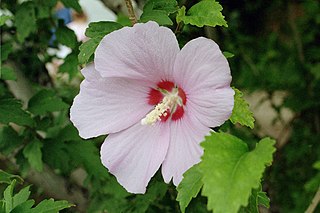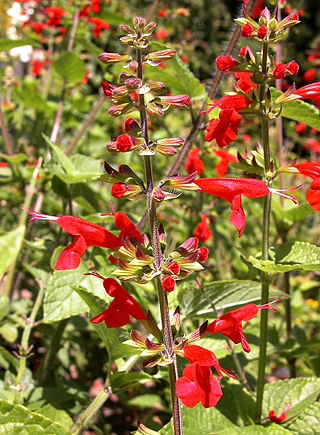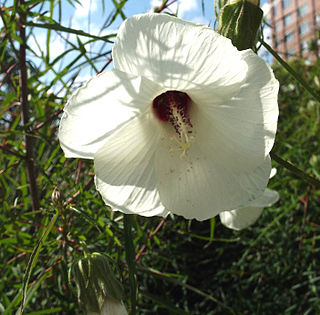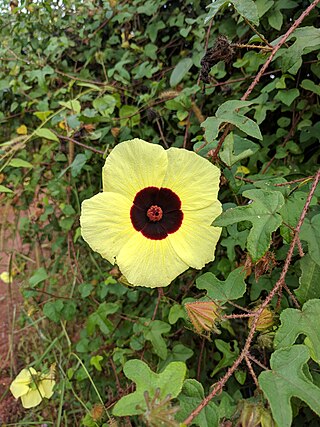
Hibiscus is a genus of flowering plants in the mallow family, Malvaceae. The genus is quite large, comprising several hundred species that are native to warm temperate, subtropical and tropical regions throughout the world. Member species are renowned for their large, showy flowers and those species are commonly known simply as "hibiscus", or less widely known as rose mallow. Other names include hardy hibiscus, rose of sharon, and tropical hibiscus.

Aesculus pavia, known as red buckeye or firecracker plant, is a species of deciduous flowering plant. The small tree or shrub is native to the southern and eastern parts of the United States, found from Illinois to Virginia in the north and from Texas to Florida in the south. It is hardy far to the north of its native range, with successful cultivation poleward to Arboretum Mustila in Finland.

Phaseolus coccineus, known as runner bean, scarlet runner bean, or multiflora bean, is a plant in the legume family, Fabaceae. Another common name is butter bean, which, however, can also refer to the lima bean, a different species.

Hibiscus syriacus is a species of flowering plant in the mallow family, Malvaceae. It is native to areas of east Asia, but widely introduced elsewhere, including much of Europe and North America. It was given the epithet syriacus because it had been collected from gardens in Syria. Common names include the rose of Sharon,, Syrian ketmia, shrub althea, and rose mallow. It is the national flower of South Korea and is mentioned in the South Korean national anthem.

Hibiscus waimeae is a species of flowering plant within the okra family, Malvaceae, that is endemic to the island of Kauaʻi in Hawaii.

Hibiscus clayi, common names red Kauai rosemallow, Clay's hibiscus or Kokiʻo ʻula, is a perennial angiosperm of the mallow family Malvaceae.

Hibiscus grandiflorus, the large-flowered hibiscus or swamp rosemallow, is a species of flowering plant in the mallow family, Malvaceae. It Is native to the southern United States, from southeast Texas, to southern Florida as well as western Cuba. It is historically known from South Carolina. It favors wet habitats, especially tidal marshes, as well as lakeshores and wet pine savannas. Its flowers serve as a nectar source for hummingbirds, and its fruits provide seeds for other birds.

Hibiscus acetosella, the cranberry hibiscus or African rosemallow, is a flowering plant of the family Malvaceae. The epithet acetosella is of Latin origin and is a diminutive of the Latin name for sorrel which comes from the sour taste experienced when eating the young leaves of both plants. Hibiscus acetosella is also known colloquially as false roselle, maroon mallow, red leaved hibiscus, and red shield hibiscus. It is one of the approximately 200–300 species that are seen in sub-tropic and tropic regions. This ornamental is usually found in abandoned fields or open areas, marshes, and forest clearings. Cranberry hibiscus is a member of a perennial group known as hardy hibiscus. In contrast to the tropical hibiscus, hardy hibiscus can tolerate colder conditions, are more vigorous, longer lasting, and have larger flowers. In colder climates, Hibiscus acetosella is easily an annual, but is often regarded as a perennial to zone 8–11. During one season, the plant can grow 90–170 cm (3.0–5.6 ft) tall and 75 cm (30 in) wide as a shrub-subshrub.

Hibiscus moscheutos, the rose mallow, swamp rose-mallow, crimsoneyed rosemallow, or eastern rosemallow, is a species of flowering plant in the family Malvaceae. It is a cold-hardy perennial wetland plant that can grow in large colonies. The hirsute leaves are of variable morphology, but are commonly deltoidal in shape with up to three lobes. It is found in wetlands and along the riverine systems of the eastern United States from Texas to the Atlantic states, its territory extending northward to southern Ontario.

Hibiscus mutabilis, also known as the Confederate rose, Dixie rosemallow, cotton rose or cotton rosemallow, is a plant long cultivated for its showy flowers. Originally native to southern China, it is now found on all continents except Antarctica.

Hibiscus schizopetalus is a species of Hibiscus native to tropical eastern Africa in Kenya, Tanzania and Mozambique. Its common names include fringed rosemallow, Japanese lantern, coral hibiscus, and spider hibiscus.

Salvia coccinea, the blood sage, scarlet sage, Texas sage, or tropical sage, is a herbaceous perennial in the family Lamiaceae that is widespread throughout the Southeastern United States, Mexico, Central America, the Caribbean, and northern South America. At one time Brazil was considered to be where it originated, but its diploid chromosome count now points to Mexico as its place of origin.

Lonicera sempervirens is a flowering plant species of honeysuckle vine native to the eastern United States which is known for its reddish flowers.

Sphaeralcea ambigua, is a species of flowering plant commonly known as desert globemallow or apricot mallow, is a member of the genus Sphaeralcea in the mallow family (Malvaceae).

Hibiscus radiatus is native to southern and southeast Asia. It has 15 cm (5.9 in) mauve flowers that have a purple center and yellow anthers. Leaves are dentate, with upper leaves lobed into three, five, or seven parts. Leaves are mistaken as marijuana, but radiatus' stems have small thorns. It is frequently grown as a vegetable or medicinal herb.

Fothergilla major, the large witch alder or mountain witch alder, is a species of flowering plant in the genus Fothergilla, family Hamamelidaceae, that is native to woodland and swamps in the Allegheny Mountains and southern Appalachian Mountains of the southeastern United States. It is a deciduous shrub growing to 2.5 m with fragrant white bottlebrush flowers appearing along with, or before, the glossy leaves. The leaves often turn brilliant shades of red and orange in autumn.

Hibiscus striatus, the striped hibiscus or striped rosemallow, is a plant in the mallow family, Malvaceae. Its flowers are 5 inches across, some of the largest flowers of any mallow plant.

Hibiscus dasycalyx is a species of hibiscus known by the common name Neches River rosemallow. It is endemic to Texas in the United States, where there are three remaining natural populations and three introduced populations.

Hibiscus aculeatus is a species of plant in the family Malvaceae. Common names include comfortroot and pineland hibiscus.
Hibiscus paramutabilis, the everblooming Confederate rose, is a species of flowering plant in the family Malvaceae, native to southeastern China. A deciduous shrub reaching 1 to 4 m at maturity, in the wild it is found in scrubland, slopes, and valleys from 500 to 1,100 m above sea level. In the garden it is hardy to USDA zone 7a, and produces white, pink or rose‑pink flowers that are 15 to 30 cm wide, blooming from spring to early winter.























